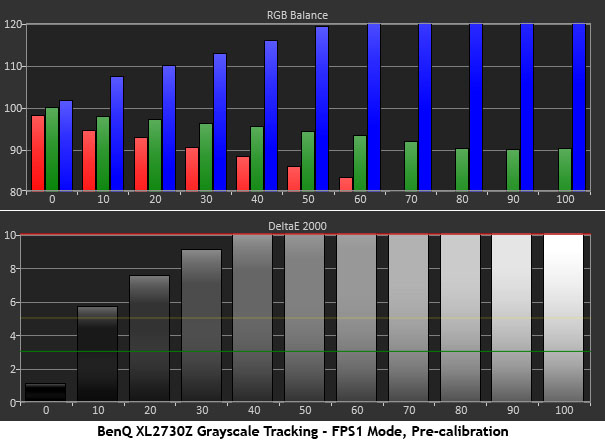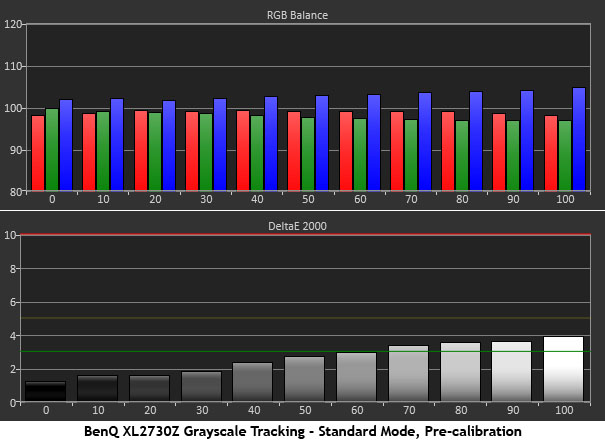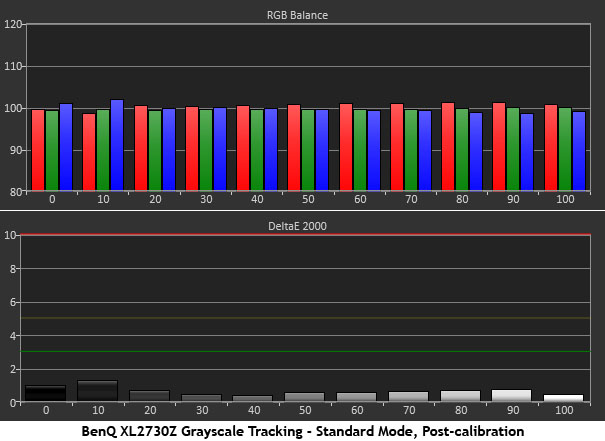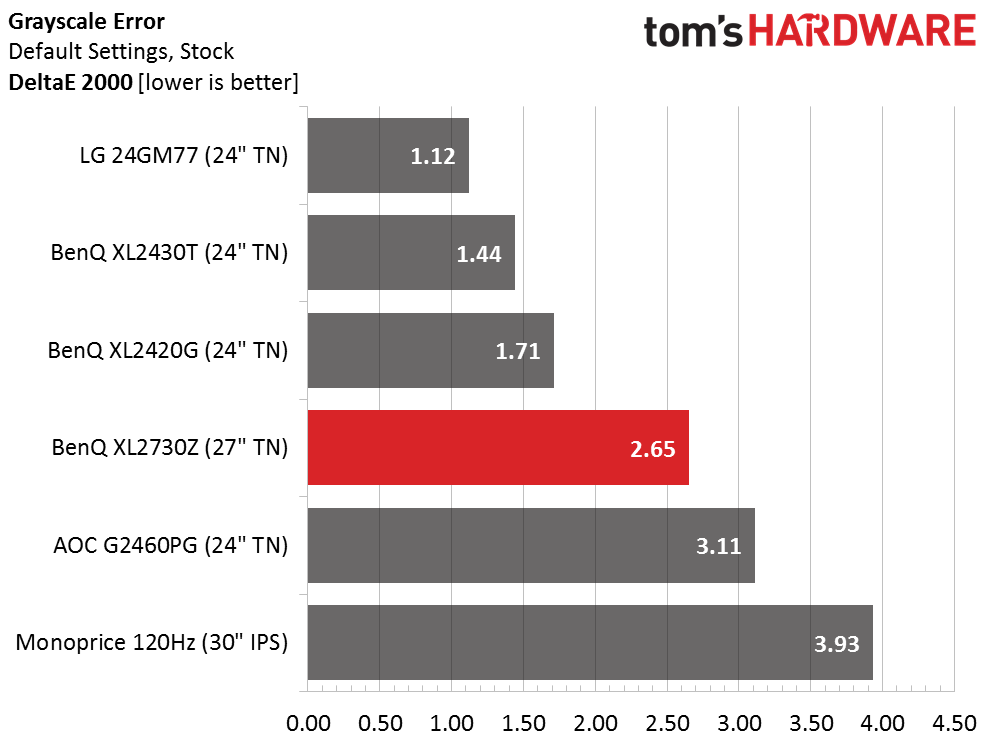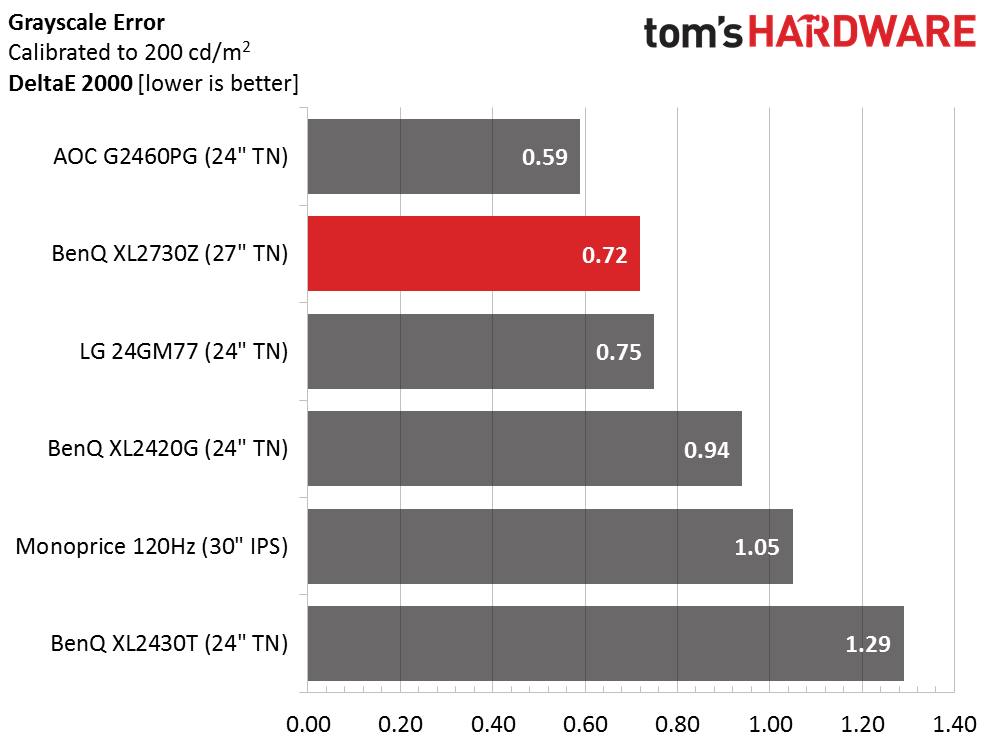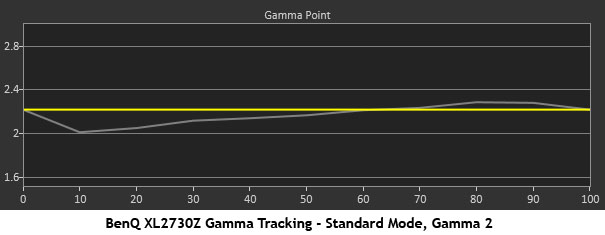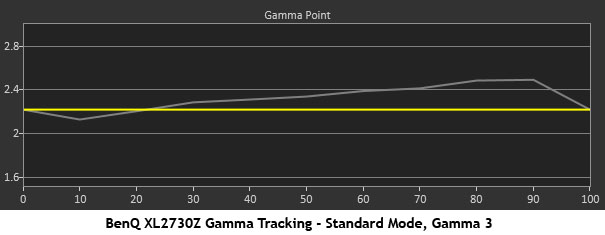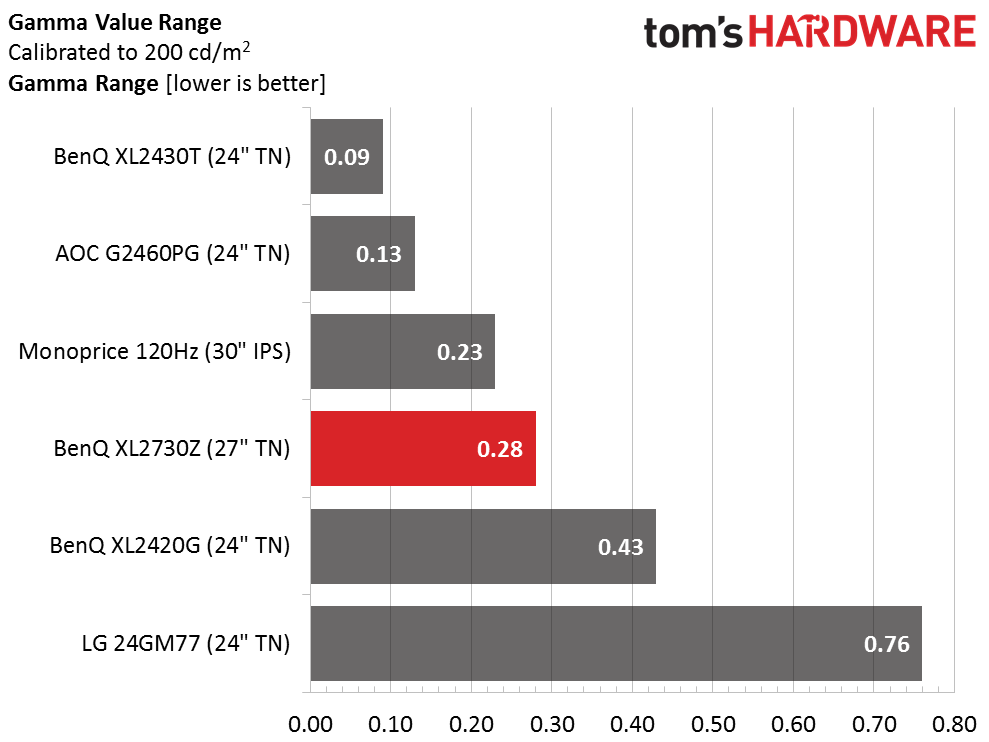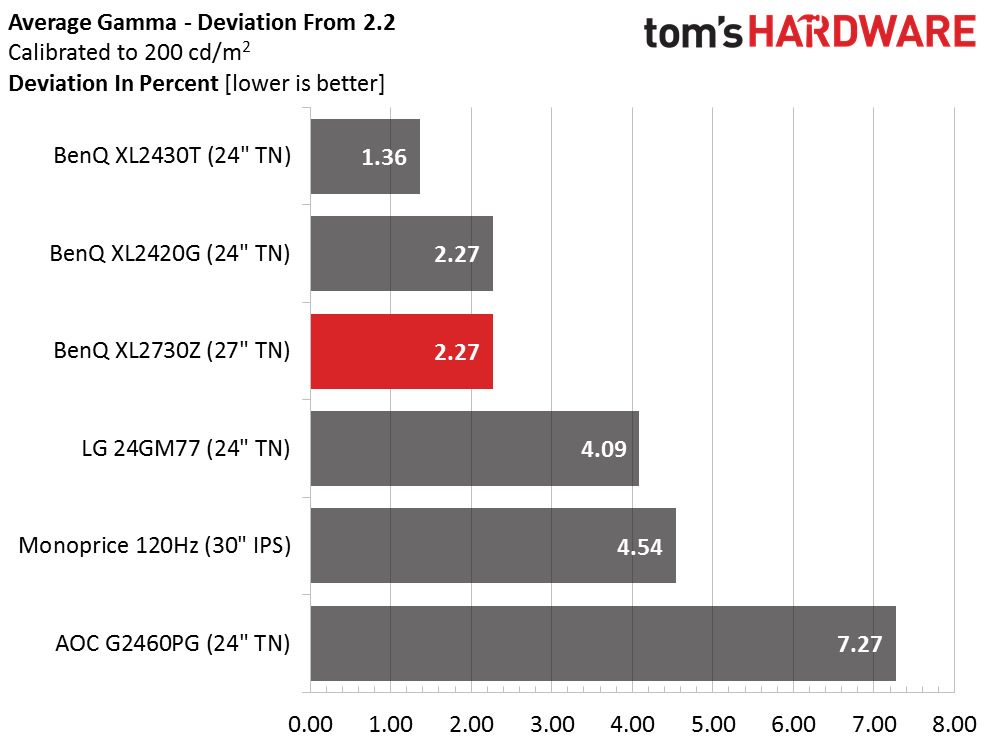BenQ XL2730Z 27-inch FreeSync Monitor Review
For our first chance to examine AMD’s FreeSync, BenQ sent us its brand-new XL2730Z, and we’re running it through our demanding suite.
Why you can trust Tom's Hardware
Grayscale Tracking And Gamma Response
Our grayscale and gamma tests are described in detail here.
The XL2730Z comes set to its FPS1 picture mode from the factory. The main flaw with that is an extremely blue white point. You can change the color temp preset, but we want to show you the monitor in its default state. Once you’re accustomed to 6500K, this panel looks very blue. It also contributes to a dull flat image.
Changing the picture mode to Standard makes for a significant improvement. Now there are only slight blue errors at 70 percent and above. If you don’t want to calibrate, this is a perfectly acceptable alternative.
Since we can’t leave well enough alone, we tweaked the RGB controls and generated an excellent chart. It doesn’t get much better than this pro-level result.
Here is our comparison group:
A 2.65dE measurement is an adequate default grayscale error for a gaming monitor. It’s far from a deal-breaker, though some other monitors behave a little better. Given the XL2730Z’s other qualities, we’re pretty sure it won’t dissuade buyers.
We’re happy to see more and more displays capable of sub-one DeltaE grayscale performance. It wasn’t long ago that this was only possible in expensive professional-grade screens. These gaming monitors aren’t cheap, but they do cost a lot less than a typical factory-calibrated product.
Get Tom's Hardware's best news and in-depth reviews, straight to your inbox.
Gamma Response
Here’s the default FPS1 mode gamma result. It emphasizes shadow detail and clips heavily at the brighter end of the scale. Regardless of content, we don’t think this makes for a good image. The XL2730Z is capable of much more depth and dimension.
Just switching to the Standard mode and changing the preset to Gamma 2 makes things much better. Now there’s only a slight dip at the 10- and 20-percent levels, which is pretty much invisible to the naked eye.
Changing to the Gamma 3 preset gives you the same tracking, but at a slightly darker level. Depending on your room lighting, this might offer greater perceived contrast. You can switch between the two settings without affecting other image parameters.
Here is our comparison group again:
A .28 range in gamma values means tracking is fairly tight. The main culprit is the dip at the low end of the brightness scale. Overall, it looks perfect to our eyes.
We calculate gamma deviation by simply expressing the difference from 2.2 as a percentage.
The closest we could get to a 2.2 average value was 2.15 (2.27% deviation) using the Gamma 2 preset. If you go for Gamma 3, the average is 2.33. Since color is not affected, the choice comes down to user preference.
Current page: Grayscale Tracking And Gamma Response
Prev Page Brightness And Contrast Next Page Color Gamut And Performance
Christian Eberle is a Contributing Editor for Tom's Hardware US. He's a veteran reviewer of A/V equipment, specializing in monitors. Christian began his obsession with tech when he built his first PC in 1991, a 286 running DOS 3.0 at a blazing 12MHz. In 2006, he undertook training from the Imaging Science Foundation in video calibration and testing and thus started a passion for precise imaging that persists to this day. He is also a professional musician with a degree from the New England Conservatory as a classical bassoonist which he used to good effect as a performer with the West Point Army Band from 1987 to 2013. He enjoys watching movies and listening to high-end audio in his custom-built home theater and can be seen riding trails near his home on a race-ready ICE VTX recumbent trike. Christian enjoys the endless summer in Florida where he lives with his wife and Chihuahua and plays with orchestras around the state.
-
norseman4 I don't understand why the price is so high. The only things I see that are different (in any meaningful way) from the Acer XG270HU (which I have, and am a fan of) is hight adjustment and an external puck to load configurable screen settings. (that is pretty cool though)Reply
The Acer also doesn't have the raised bezel that is actually about 8mm (Top, Left and Right)
The Benq looks like a good monitor, I just don't see what justifies the premium price. -
Xajel I'll wait for 29" 21:9 1440p instead, the only option available is curved, which is pricey, I don't see the curvation worth the extra cost... FreeSync is a plus but this will drive the cost up again ( to have a 144Hz panel at that resolution )... and please add a USB 3.1 hub with 2x Type-A & 2x Type-C portsReply -
eklipz330 i may have missed it in the article, but what is the range of frames freesync covers on this monitor?Reply -
I Hate Nvidia Replyi may have missed it in the article, but what is the range of frames freesync covers on this monitor?
First thing I was thinking of is FreeSync Range , and I double checked the article and there is no mention of it at all! I think the writer is not well informed regarding FreeSync - GSync Range.
-
JTWrenn This was a good article for a monitor review....it was a very bad article for one of the first Freesync monitors to be released. Many of us wanted more info on that and you acted like all monitors are the same as long as the tech works...that is just not true. Please add more about the Freesync tech, how it worked and what it's limitations were.Reply -
singemagique Why does the author not add a comparison to the Acer XB270HU? Instead they make reference to the ROG Swift? At ~$740, the XB270HU offers 1440p, 144hz, and Gsync on an IPS panel and is definitely at the top of my list at this price point. Could Toms please add info on the Acer panel to this review?Reply -
Falkentyne Christian, I sent you an email about Version 4 firmware for the previous monitor you reviewed--the XL2720Z.Reply
And "Area" is the same thing as "strobe phase" is on the older Z series.
http://forums.blurbusters.com/viewtopic.php?f=13&t=560 -
Bondfc11 He says it's 40-144, but has that been tested? Or is that just the normal statement? Recall plenty of FS monitors state a range and then the panel won't oblige once it was properly tested.Reply -
Falkentyne That's the refresh rate capability, NOT the blur reduction rate capability. The older Z series can't even single strobe at 50hz without a Vertical Total tweak which tricks the scaler into using 60hz backlight pulse widths (if you try single strobe at 50hz without it, the backlight becomes overdriven with voltage and the current makes the monitor reset from overcurrent protection.Reply
It can "double strobe" at 50hz and 60hz but that's only because the single strobe option is missing from the service menu (it was there in all of the previous benq blur reduction monitors including the 2430T).
